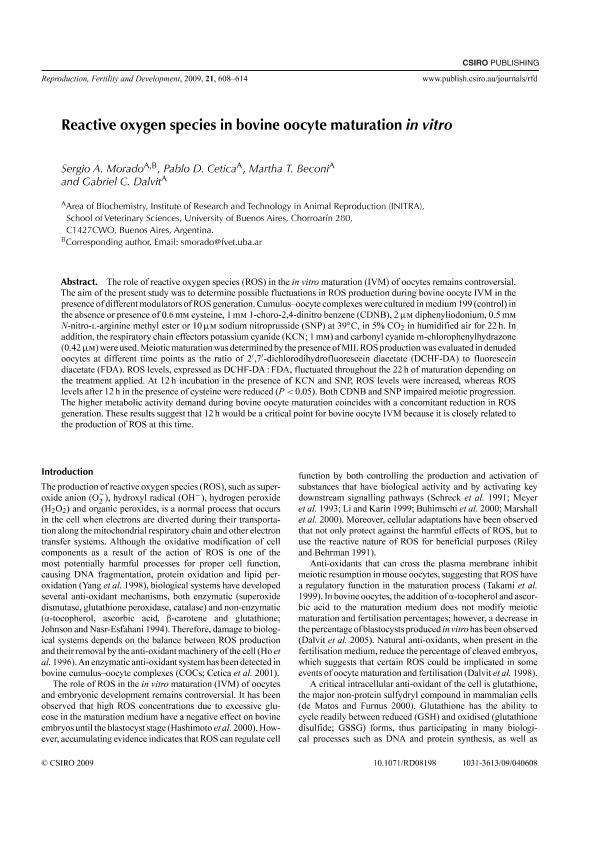Mostrar el registro sencillo del ítem
dc.contributor.author
Morado, Sergio Adrián

dc.contributor.author
Cetica, Pablo Daniel

dc.contributor.author
Beconi, Martha Teresa

dc.contributor.author
Dalvit, Gabriel Carlos

dc.date.available
2020-03-06T19:59:03Z
dc.date.issued
2009-12
dc.identifier.citation
Morado, Sergio Adrián; Cetica, Pablo Daniel; Beconi, Martha Teresa; Dalvit, Gabriel Carlos; Reactive oxygen species in bovine oocyte maturation in vitro; Csiro Publishing; Reproduction Fertility and Development; 21; 4; 12-2009; 608-614
dc.identifier.issn
1031-3613
dc.identifier.uri
http://hdl.handle.net/11336/98978
dc.description.abstract
The role of reactive oxygen species (ROS) in the in vitro maturation (IVM) of oocytes remains controversial. The aim of the present study was to determine possible fluctuations in ROS production during bovine oocyte IVM in the presence of different modulators of ROS generation. Cumulus-oocyte complexes were cultured in medium 199 (control) in the absence or presence of 0.6 mm cysteine, 1mm 1-choro-2,4-dinitro benzene (CDNB), 2μm diphenyliodonium, 0.5 mm N-nitro-l-arginine methyl ester or 10 μm sodium nitroprusside (SNP) at 39°C, in 5% CO2 in humidified air for 22 h. In addition, the respiratory chain effectors potassium cyanide (KCN; 1 mm) and carbonyl cyanide m-chlorophenylhydrazone (0.42 μm) were used. Meiotic maturation was determined by the presence of MII. ROS production was evaluated in denuded oocytes at different time points as the ratio of 2′,7′- dichlorodihydrofluorescein diacetate (DCHF-DA) to fluorescein diacetate (FDA). ROS levels, expressed as DCHF-DA : FDA, fluctuated throughout the 22 h of maturation depending on the treatment applied. At 12 h incubation in the presence of KCN and SNP, ROS levels were increased, whereas ROS levels after 12 h in the presence of cysteine were reduced (P < 0.05). Both CDNB and SNP impaired meiotic progression. The higher metabolic activity demand during bovine oocyte maturation coincides with a concomitant reduction in ROS generation. These results suggest that 12 h would be a critical point for bovine oocyte IVM because it is closely related to the production of ROS at this time.
dc.format
application/pdf
dc.language.iso
eng
dc.publisher
Csiro Publishing

dc.rights
info:eu-repo/semantics/openAccess
dc.rights.uri
https://creativecommons.org/licenses/by-nc-sa/2.5/ar/
dc.subject
Oocyte
dc.subject
In vitro maturation
dc.subject
Reactive oxygen species
dc.subject
Bovine
dc.subject.classification
Ciencias Veterinarias

dc.subject.classification
Ciencias Veterinarias

dc.subject.classification
CIENCIAS AGRÍCOLAS

dc.title
Reactive oxygen species in bovine oocyte maturation in vitro
dc.type
info:eu-repo/semantics/article
dc.type
info:ar-repo/semantics/artículo
dc.type
info:eu-repo/semantics/publishedVersion
dc.date.updated
2020-02-07T13:46:33Z
dc.journal.volume
21
dc.journal.number
4
dc.journal.pagination
608-614
dc.journal.pais
Australia

dc.journal.ciudad
Collingwood
dc.description.fil
Fil: Morado, Sergio Adrián. Universidad de Buenos Aires. Facultad de Ciencias Veterinarias. Instituto de Investigacion y Tecnología en Reproducción Animal; Argentina. Consejo Nacional de Investigaciones Científicas y Técnicas; Argentina
dc.description.fil
Fil: Cetica, Pablo Daniel. Consejo Nacional de Investigaciones Científicas y Técnicas; Argentina. Universidad de Buenos Aires. Facultad de Ciencias Veterinarias. Instituto de Investigacion y Tecnología en Reproducción Animal; Argentina
dc.description.fil
Fil: Beconi, Martha Teresa. Universidad de Buenos Aires. Facultad de Ciencias Veterinarias. Instituto de Investigacion y Tecnología en Reproducción Animal; Argentina. Consejo Nacional de Investigaciones Científicas y Técnicas; Argentina
dc.description.fil
Fil: Dalvit, Gabriel Carlos. Consejo Nacional de Investigaciones Científicas y Técnicas; Argentina. Universidad de Buenos Aires. Facultad de Ciencias Veterinarias. Instituto de Investigacion y Tecnología en Reproducción Animal; Argentina
dc.journal.title
Reproduction Fertility and Development

dc.relation.alternativeid
info:eu-repo/semantics/altIdentifier/doi/https://doi.org/10.1071/RD08198
dc.relation.alternativeid
info:eu-repo/semantics/altIdentifier/url/https://www.publish.csiro.au/rd/RD08198
Archivos asociados
